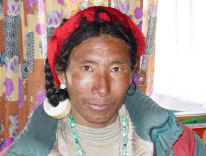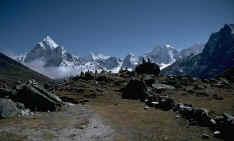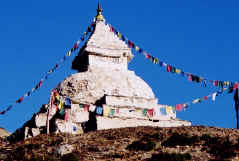 WHO
ARE WE? Our name , Sherpa means
"easterner" because we came from the Kham in eastern Tibet. One of the
first persons to come to Khumbu came by way of the Rolwaling valley and Tashi
Labrsa (pass). He opened this valley so other people could come to settle. Later
many families came from Tibet over the Nangpa La (pass).
WHO
ARE WE? Our name , Sherpa means
"easterner" because we came from the Kham in eastern Tibet. One of the
first persons to come to Khumbu came by way of the Rolwaling valley and Tashi
Labrsa (pass). He opened this valley so other people could come to settle. Later
many families came from Tibet over the Nangpa La (pass).
This person came to Khumbu from
Kham-Salmo-Gang (east of Tibet). His clan was called Thimi. When he came to Tibet, the people asked where he came from- "the
cast part of Kham." That is how the name Sher-pa, meaning east-people, came
to be.
For 600 years, people have migrated
from Tibet to these mountain valleys in Nepal. There was a time of great unrest
in Tibet when many lamas, their families and followers left their homes looking
for new places to live. They settled in the mountain valleys of northern
Nepal. These places came to be called Yolmo (Helambu), Langtang, and Khumbu.
Now we live in the Solu-Khumbu
district, Sagarmatha zone of Nepal. We live in the highest places. In the Khumbu,
we number about 3,200, with another 30,000 Sherpas living in the Solu, Langtang,
Helmabu, and Rolwaling valleys.
The Sherpa language (a dialect of
Tibetan), literature, history, and philosophy came from old Tibetan religious
books.
Today approximately 30,000 Sherpas live in Nepal,
and around 3000 of them live in the Khumbu region on the south side of Everest.
Since the 1950s, tourism has become the dominant source of employment and income
in the area. Many Sherpas, as well as people from other ethnic groups, work as
part of the climbing and tourism industry.
While the Sherpa people retain their Buddhist religion and many of their traditional practices, this shift in the local economy and way of life has necessarily meant changes in the Sherpa culture. Among these, there has been a shift from regarding climbing the mountain as blasphemous, to regarding it as a source of economic opportunity and pride.
Sherpas hold many impressive Everest records, including most times summitted for men and women, quickest ascent, quickest descent, most time spent on top and youngest climber to reach the summit.
 ABOUT
THE KHUMBU VALLEY; To tell a short story about the Khumbu: here is the
highest mountain in the world. They call it Jomolangma, because a goddess, one
of the five sisters of long life, resides there.
ABOUT
THE KHUMBU VALLEY; To tell a short story about the Khumbu: here is the
highest mountain in the world. They call it Jomolangma, because a goddess, one
of the five sisters of long life, resides there.
Guru Ringpoche, the found of Tibetan
Buddhism, hid the Khumbu and other Himalayan valley for future times when people
would need them as sanctuaries. He described Khumbu in religious books as a
valley surrounded by snow peaks. Following directions in these tests, some people
moved into there area of northern Nepal.
There are two main areas where the
Sherpas live. In the old times, they called the upper Khumbu valley, Khumbu-te,
and the lower Solu valley, Shorung. When they first came here, now covered the
Khumbu Valley and the glaciers here were much bigger. Hence, the first
settlements were down near Lukla. As the snow and ice gradually melted, people
moved up to Tashinga, and then eventually started villages at Khumjung and
Pangboche.
The main villages in Khumbu are
Khumjung, Kunde, Thamichhok, Namche, Pangboche, and Phortse. Most Sherpas have
home in one of these villages but often stay for the summer monsoon in huts at
the high pastures. RELIGION AND CULTURE; In solu-Khumbu the most common sect of Tibetan
Buddhism is the Nyingmapa, the oldest tradition. Sherpa and Tibetan lamas taught
this religion to the people and organized the communities.
RELIGION AND CULTURE; In solu-Khumbu the most common sect of Tibetan
Buddhism is the Nyingmapa, the oldest tradition. Sherpa and Tibetan lamas taught
this religion to the people and organized the communities.
These sherpa and Tibetan ngagpa (lay
lamas) brought teaching from Tibet to Khumbu that were from Books hidden by the
founder of Tibetan Buddhism, Gura Rinpoche. Lamas called tertons are
incarnations of Guru Rinpoche who rediscovered these hidden teachings. Ter means
"spiritual treasure" in Tibetan. A lama named Rigdzin Godem found some
of these books, the Chang-ter, hidden in northern TIbet. The other lama, Nyatak-
Nyung, found the Lho-ter in southern Tibet. The terton, Terdak Lingpa found the
books and wrote the texts used in the Sherpa's pujahs,
religious rituals.
As more people came to Khumbu,
traditions started that helped to unite the villagers and to project the valley.
Daily life revolves around each villages gompa (temple). Closely tied to
Buddhist beliefs are their daily activates of farming, herding and trading.
Since the 1950's they have worked for tourists and earned fame on climbing
expeditions.
The Sherpa language originated from
the old Tibetan religious books. There are many different dialects used in
Tibet. As well, words from other languages such as Newar, Nepali, Tamang, and
English have gradually come into their speech. The Tibetan language from Lhasa
has also changed since that time.
Before 1959, most Sherpas farmed and
traded with Tibet. The business with Tibet was usually for salt and wool. Today,
most people work mountaineering, trekking, portering, or doing religious
services. The old people spend some of their time saying whatever prayers they
know, going around stone mani walls and village lha-khangs, and helping
with their families.
Potatoes, buckwheat, and barley are
traditionally the main foods in Khumbu. Except for items brought up by traders,
Sherpa food is limited to crops that can grow at the cold, high altitudes of the
Khumbu. Sherpas eat some Tibetan foods, such as tsampa (roasted barley flour),
and some Nepali food such as rice. Unique to the Sherpas are green vegetables
that are cooked then fermented to keep, and kyu, a sour or salty porridge
of many grains-corn, rice, millet.
The Sherpas grow potatoes,
buckwheat, barley turnips, and greens. Dairy products include butter, yogurt,
and cheese. They purchase rice, lentils, corn, millet and fresh meat from
down-valley traders at the market. Salt and dried sheep meat is obtained from
traders coming from Tibet.
No comments:
Post a Comment